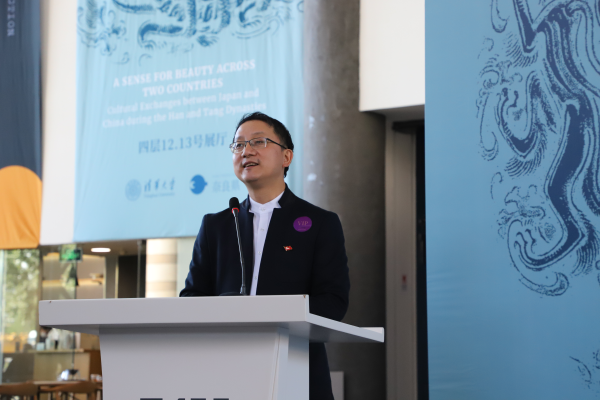
People’s Republic of China



On September 23, 2022, Director-General of the Department of Asian Affairs of the Foreign Ministry Liu Jinsong attended and addressed the opening ceremony of the special exhibition themed "A Sense for Beauty across Two Countries: Cultural Exchanges between Japan and China during the Han and Tang Dynasties" co-hosted by Tsinghua University and Nara Prefecture Government of Japan at Tsinghua University Art Museum.
Liu Jinsong congratulated Tsinghua University and Nara Prefecture Government on successfully holding the exhibition despite the challenges of the pandemic, noting that this year marks the 50th anniversary of the normalization of diplomatic relations between China and Japan; the timing of the exhibition could not be more appropriate.
Liu Jinsong recalled the grand scenes of the “homecoming visit” to Yangzhou by the sitting statue of Jianzhen from Tōshōdai Temple of Nara, Japan in 1980, the earliest record of Japan's reigning title found in the inscription of the monument of Ino Manari in Xi'an and the rapturous welcome it received when the monument was exhibited in Japan in 2005, the sincere friendship and literary exchanges between Japanese envoy to China's Tang Dynasty Abe Nakamaro and the well-known Chinese poet Li Bai, and the cultural exchanges between the Four Literati of Liu’s hometown Yuyao and Japan -- all these stories have left him with a deep impression. Liu Jinsong went on to say that China and Japan are close neighbors separated only by a strip of water. Peace and friendship have been the defining feature of their over 2,000 years of exchanges. Learning from each other, the two peoples have promoted the development of their respective countries and made important contributions to the progress of human civilizations in Asia and beyond. Liu quoted President Xi Jinping as saying that "The China-Japan friendship is rooted in the people, and the future of the bilateral relationship is in the hands of the people of the two countries. The more headwinds the development of bilateral relations encounters, the more necessary it is for both sides to strengthen non-governmental exchanges to create the conditions and environment for improving and developing bilateral relations". Liu also noted that the visit to the exhibition will help them better understand the profound meaning of President Xi Jinping's important remarks. He called for joint effort of the two sides to promote deeper friendship and mutual understanding between the two peoples, and build a China-Japan relationship that answer the call of the new era.
* * * * * *
Minister of the Japanese Embassy in China Kijima Yoshiko, Governor of Nara Prefecture of Japan Arai Shōgo, Director of the Archaeological Institute of Kashihara in Japan Aoyagi Masanori, representative of Japanese exhibition planners Umino Hiroyuki, Vice President of Tsinghua University Wang Hongwei, and Executive Director of Tsinghua University Art Museum Du Pengfei attended and addressed the opening ceremony. They pointed out in their speeches that the exhibition has reflected the depth of cultural integration between China and Japan in history, and how popular and well received was the Chinese culture of the Han and Tang dynasties in the Japanese society, noting that this is an important event conducive to promoting exchanges between China and Japan in arts, history and culture. They also stressed the need for China and Japan to promote cultural exchanges at all levels, and make sustained efforts to enhance mutual understanding between the two peoples, and carry forward bilateral friendship from generation to generation.
The special exhibition featured more than 100 sets of China-related cultural relics from the Archaeological Institute of Kashihara in Nara Prefecture and other Japanese institutions, and dozens of Japan-related cultural relics from Chinese cultural museums and institutions.


